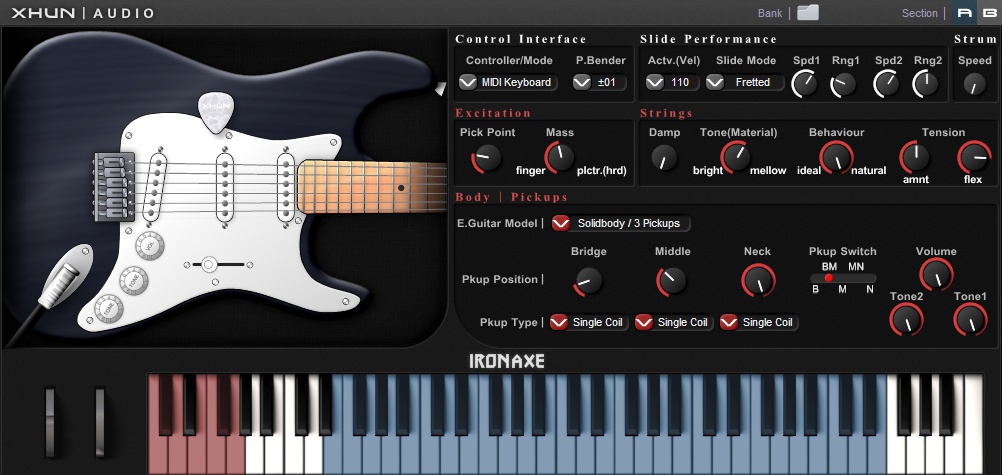Introduction
The technique of playing the electric guitar is a complex process that requires mastering a number of basic techniques through special exercises. The traditional method of playing the electric guitar is picking. To improve the accuracy of this technique in order to capture the necessary strings and increase melodic mobility, one can use the following exercise. Usually, to improve this technique, etudes are used to play scales with a progressive increase and decrease in tone and the position of the fingers clamping the strings. However, this method is even more effective if one uses alternate, inconsistent picking.
Thus, the reproduction of sounds goes by alternating through one string, which gives additional development of muscle memory and finger mobility. This allows for more complex and melodically wide guitar licks in the future. This scale can be played progressively by raising the position of the fingers on the frets by a semitone. Having mastered this musical pattern, it makes sense to try to play it under the metronome, gradually increasing the speed, thus increasing the technicality of the performance. You can also sound each component note a certain number of times using the tremolo picking technique. Considering that tremolo performance is also one of the important techniques, practicing it on a wide string spread will give the hand additional stability when producing sound. Tremolos can also be rhythmically varied, ranging from three to four notes, which allows one to further master the combination of melody and rhythmic counting.
Sweep picking is a very popular technique among electric guitarists that uses sweepinr or raking to pick up sequences of notes faster. This type of picking can be used to play arpeggios, pentatonic, note scales. It equires maximum synchronization between the pick and finger fretting. The essence of this type of sound extraction is that at one moment only one note should sound strictly, while all the other strings are muffled by the fingers, which produces such a graceful effect. It is necessary to play under a metronome with a gradually accelerating tempo. Grouping notes into blocks of different rhythms and sizes, such as triplets or 16th notes, helps develop rhythmic mastery as the tempo increases.
In fact, picking is a slowed down version of stramming, that is, the simultaneous sounding of all six strings while holding down a chord. Picking strikes each of these notes separately, but it’s important to keep the hand moving as if playing a chord to perfect this technique. The hand that strikes the note should move as softly and relaxed as possible, while striving for rhythmic uniformity. The left hand, which is holding the notes, may first rest on the selected chord, but subsequently must synchronize with the note being played, drowning out the rest of the strings.
New Technologies and Electric Guitars
Since the beginning of the 21st century, digital technologies have been gradually introduced into various aspects of the production of electric guitars and accompanying equipment, which allows us to talk about their prospects in the future. Guitar synthesizers in particular are a prime example of this technological integration. The pickup system developed by Roland introduces MIDI technology into the sound production process, transforming the played note into any digital sound (Warehouse USA, 2022). This does not affect the complexity or principle of the performance itself, since the strings remain the same nylon, however, the principle of capturing and transforming information turns out to be digital rather than analog. This allows a variety of synth sounds to be assigned to specific notes, from trumpets and keyboards to virtual drums controlled through traditional string playing. The technology is quite promising and is also used by other companies, such as Casio.
Signal digitalization techniques can also be used differently by electric guitar manufacturers. Some guitars have built-in Auto-Tune, which passes the analog signal through digital, providing it with additional amplified melodic tuning. Some guitars are equipped with valuable controllable computer processors, equipped with buttons for control. Also, touchpads-caoscilators are being introduced into some models of guitars, allowing one to distort the sound when in contact with them. The sound change can be both pitch and frequency as the sound can be passed through an equalizer. It should be added that in the world of computer software a very large number of programs are being developed to change the sound. VST plug-ins allow to distort the sound beyond recognition on the air when you synchronize your guitar and a computer or tablet through special wired and wireless communications.
Thus, digitalization and the introduction of microchips into an analog electric guitar is still a promising direction for development. However, it should be noted that the nostalgia for analog sound in electric guitar circles is so strong that one can hardly talk about fully replacing standard guitars with digital guitars in the foreseeable future. Such innovations in sound will be used by enthusiasts and experimenters, but are unlikely to capture the mass audience of musicians and performers.
The limits in which the production of guitars can develop are also related to the disclosure of additional capabilities of the guitarist. A guitar with two or even three necks, for example, allows the player to fully occupy several different-sounding instruments. The cultural background of such guitars goes back to the Renaissance lutes, but at the moment such guitars are often used in fast-tempo metal music. Combinations of bass guitars and electric guitars in one instrument also significantly reveal the potential of the performer, giving greater polyphony to the sound. Guitars with more than six strings require special skill but can brighten up the tonal palette. 7-string guitars are able to expand the upper or lower sound range with an additional note. The extra strings in the 12-string guitar add an extra octave sound to each note, making the sound deeper and more harmonious.

Cultural Changes and Impact of Human Behavior
It makes sense to associate the transformations with the instrument with the changes taking place in culture and music. Until very recently, the electric guitar was itself the most popular and frequently used instrument in music. The rock and roll revolution has changed the way people perceive music, making it much more dynamic and expressive. However, over time, new methods of self-expression are required, dictated by new cultural attitudes. The popularity of electronic music is associated with the digitalization of the space around us. Probably, the human ear wants to hear sounds more appropriate for the new digital age. In this regard, digital guitar processors that are gaining popularity are understandable because they are capable of distorting the sound of a guitar beyond recognition.

Culture itself works on the principle that progress must be accompanied by change. Therefore, digital processors in guitars, or even completely virtual guitars working through MIDI controllers, seem to be a natural evolution of the instrument. Human behavior also influences these process changes. The need to make music in a faster, cheaper, or more efficient way causes many musicians to abandon real guitars in favor of synthetic substitutes for the instrument. Young producers or beatmakers don’t see the need to learn how to play an instrument or analog recording techniques when they can simply load a virtual guitar into a digital audio workstation. Thus, human behavior also shapes the future of the musical instrument, a fully digital copy of which can successfully replace it in some cases.
Reference
Warehouse USA (2022). Digital, the future of electic guitars?